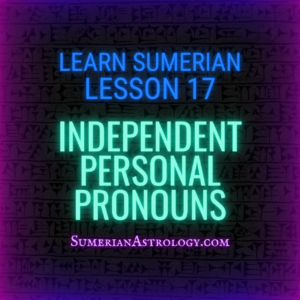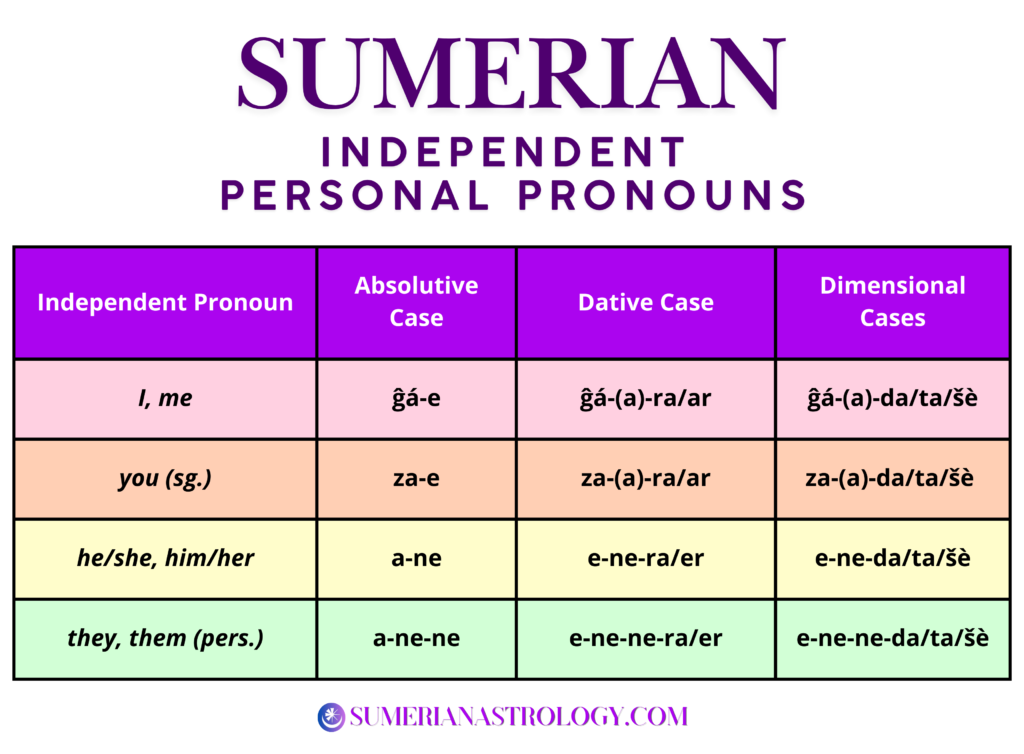Lesson 17
Sumerian Independent Personal Pronouns
In this lesson, you’ll learn all about Sumerian independent personal pronouns. While it may seam like there’s a lot to cover, personal pronouns were rarely used, and when they were, they varied, which means there isn’t one settled-upon pronoun.
I wanted to provide you with as many options as possible, as you will encounter these variations in Sumerian texts. However, I’ve provided a summary, as well as the oldest versions, which I use in my examples.
Helpful Terms
Here are some helpful terms you’ll encounter in this lesson. You can see a full list in the Glossary of Terms.
- absolutive (abs.): the standard unaltered grammatical case of a noun.
- dative (dat.): a grammatical case which indicates motion toward someone, as in ‘to/for [a person]’, marked by -ra 𒊏.
- dimensional case (dim.): In Sumerian, the dimensional cases include the ablative (from), comitative (with), and terminative (to(ward)) grammatical cases.
- ergative (erg.): a grammatical case which indicates the agent; the noun doing the action, as in ‘[performed] by’, marked by -e 𒂊.
Vocabulary to Memorize
I highly recommend memorizing these Sumerian words, as you’ll encounter them often in the upcoming lessons!
- (a-)ne 𒀀𒉈 pron., he/she (OS x7, NS x9, OB x20).
- (e-)ne (𒂊)𒉈 pron., he/she, him/her, that one (pers.) (variation: èn 𒇷 (OB)); to whom (OB); to you (pl.) (OB). part., plural marker (pers.).
- (e-)ne-ne (𒂊)𒉈𒉈 pron., they/them (pers.) (NS, OB). Variation: e-ne-e-ne 𒂊𒉈𒂊𒉈 (OB x2)
- ĝá-e 𒂷𒂊 pron., I (OS, OA, NS, OB).
- za-e 𒍝𒂊 pron., you (especially in conjunction with a copula) (may be transliterated/read as ze 𒍣 (OB x 11), or ze4-e 𒍝𒂊) (NS x1, OB x419).
Vocabulary--Full List
Here are the vocabulary terms for this lesson. Be sure to look them over as they’re updated with additional meanings each lesson. You can see the full Sumerian Lexicon here.
- an 𒀭 n., heaven; high. det., indicates the name of a deity. part., 3rd person (pers.) infix when preceded by /a/.
- (a-)ne 𒀀𒉈 pron., he/she (OS x7, NS x9, OB x20).
- (a-)né 𒀀𒉌 pron., he/she (OA x1).
- (a-)ne-ne 𒀀𒉈𒉈 pron., he/she (OS x1, OB x3).
- ba 𒁀 n., allotment, portion, wages. v., to give; pay; divide; distribute; allot. part., conjugational prefix.
- dù 𒆕 v., to beget; bear (a child); be born; build, create, fashion, make; transform, change; replace.
- é 𒂍 n., house; temple.
- èn 𒇷 pron., he/she (variation of e-ne) (OB). part., compound verbal nominal element.
- (e-)ne (𒂊)𒉈 pron., he/she, him/her, that one (pers.) (variation: èn 𒇷 (OB)); to whom (OB); to you (pl.) (OB). part., plural marker (pers.).
- (e-)ne-ne (𒂊)𒉈𒉈 pron., they/them (pers.) (NS, OB). Variation: e-ne-e-ne 𒂊𒉈𒂊𒉈 (OB x2)
- ĝá 𒂷 pron., I (especially before a case marker ending in /a/—alternative reading of ĝe26 𒂷). v., to come/go. part., in/of my; nominalizing suffix when preceded by /ĝ/.
- ĝá-a 𒂷𒀀 pron., I (Variation of ĝá-e 𒂷𒂊) (OB x2).
- ĝá-e 𒂷𒂊 pron., I (OS, OA, NS, OB).
- ĝe26 𒂷 pron. I (may be read ĝá 𒂷 before a case marker ending in /a/) (NS, OB).
- ĝe26-e 𒂷𒂊 pron. I (especially before the enclitic copula—alternative reading of ĝá-e 𒂷𒂊).
- lugal 𒈗 n., king; owner, master, lord.
- me-en 𒈨𒂗 cop., I am, you are (sg.).
- za 𒍝 pron., you (especially before a case marker ending in /a/—variation of za-e 𒍝𒂊) (NS x1, OB x 127).
- za-a 𒍝𒀀 pron., you (especially before a case marker ending in /a/—variation of za-e 𒍝𒂊, which may be transliterated/read ze4-e 𒍝𒂊) (OB x 36).
- za-e 𒍝𒂊 pron., you (especially in conjunction with a copula) (may be transliterated/read as ze 𒍣 (OB x 11), or ze4-e 𒍝𒂊) (NS x1, OB x419).
- zé 𒍢 pron., you (OB x5)
- zé-e 𒍢𒂊 pron., you (NS x1, OB x 2)

Sumerian Independent Personal Pronouns in Summary
In this lesson, we’re going to be doing things a little differently. We’ll be doing the Summary of Sumerian Independent Personal Pronouns first, followed by a detailed breakdown.
The reason for this, is that there are many variations of each, depending on the period. Fortunately, personal pronouns are rare, especially in earlier times. Unfortunately, even in later texts, the scribes couldn’t seem to agree on a standard form.
Standard Variations
Generally speaking, the Sumerian Independent Pronouns take the following forms, depending on the period.
- 1st Person Singular—I
- ĝá(-e/a) 𒂷(𒂊/𒀀)
- ĝe26(-e) 𒂷(𒂊)
- 2nd Person Singular—You
- za(-a/e) 𒍝(𒀀/𒂊)
- ze/zé/ze4(-e) 𒍣/𒍢/𒍝(𒂊)
- 3rd Person Singular (pers.)—He/She
- a/e-ne/né 𒀀/𒂊𒉈/𒉌
My Preferences
In later lessons, we’ll be using actual textual examples from Sumerian literature. However, many of the short examples I use in my lessons employ grammatical standards to help you get the hang of the various rules and concepts.
When it comes to my examples, I prefer to use the oldest variations available, preferably from the OS period.
The following are the ones you’ll see me use the most:

Breakdown of Sumerian Independent Personal Prounouns
As you’ll see, many of the personal pronouns below are just variations of the basic pronoun, which might have been spelled differently over the centuries.
In some cases, they use the same cuneiform sign, despite being read differently, which is why it’s helpful to know the date of your text!
NOTE: In the following examples, you’ll see the number of attestations in parenthesis beside the period. This shows how many times the word was used in the written record. It‘s a good idea to get familiar with looking at numbers like this. As your Sumerian language skills progress, you’ll want to have a good idea of when and how often a word was used.
NOTE: Be aware that INDEPENDENT personal pronouns ‘us’, ‘you (pl.)’, and ‘we’ are unattested in Sumerian. Possessive versions do exist as clitics, as you’ll see in the next lesson.
1st Person Singular--“I”
NOTE: The common sound in these is /ĝ/. As you’ll see in the next lesson, the possessive version also begins with /ĝ/.
2nd Person Singular--“You”
NOTE: The common sound in these is /z/. As you’ll see in the next lesson, the possessive version also begins with /z/.
Variations By Case and Plurality
In the Dative Case
- ĝá-(a)-ra/ar 𒂷(𒀀)𒊏/𒅈 to me
- za-(a)-ra/ar 𒍝(𒀀)𒊏/𒅈 to you
- e-ne-ra/er 𒂊𒉈𒊏/𒅕 to him/her
- e-ne-ne-ra/er 𒂊𒉈𒉈𒊏/𒅕 to them
In the Dimensional Cases (da/ta/šè)
- ĝá-(a)-da/ta/šè 𒂷(𒀀)𒁕/𒋫/𒂠 with/from/to(ward) me
- za-(a)-da/ta/šè 𒍝(𒀀)𒁕/𒋫/𒂠 with/from/to(ward) you
- e-ne-da/ta/šè 𒂊𒉈𒁕/𒋫/𒂠 with/from/to(ward) him/her
- e-ne-ne-da/ta/šè 𒂊𒉈𒉈𒁕/𒋫/𒂠 with/from/to(ward) them
Your Sumerian Language Journey Continues!
In the next lesson, you’ll learn about possessive pronouns, so be sure to subscribe to my substack to get notified as soon as all of my articles post!


